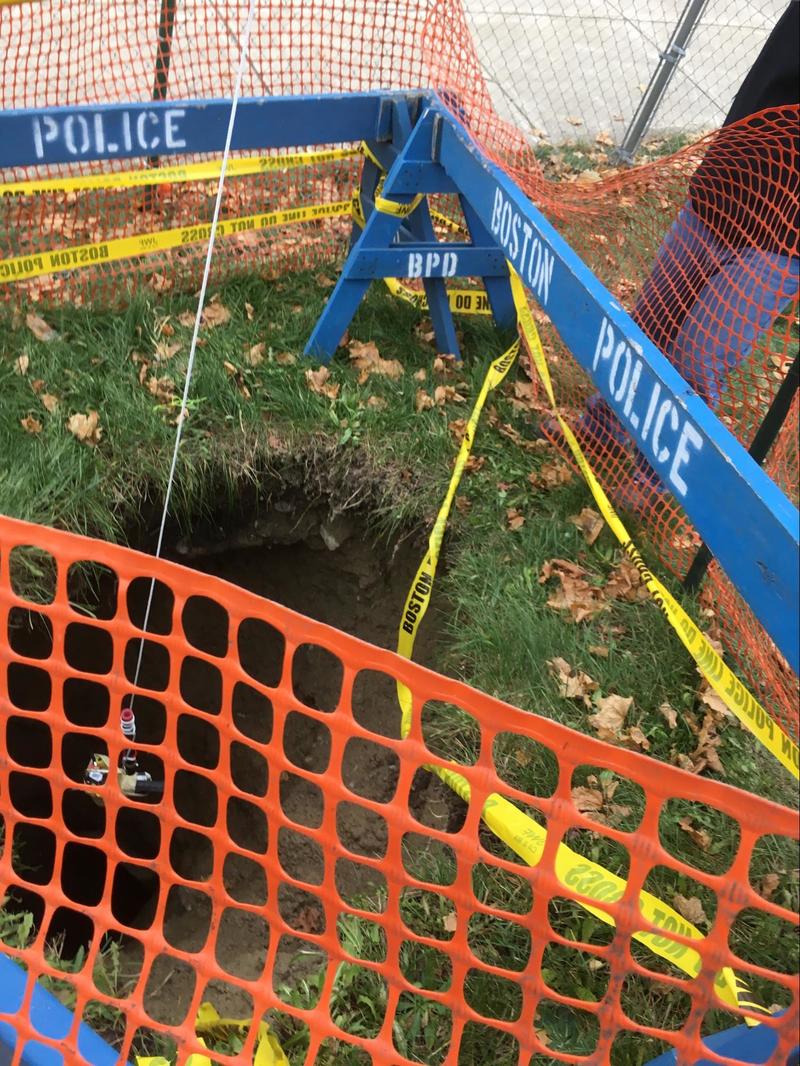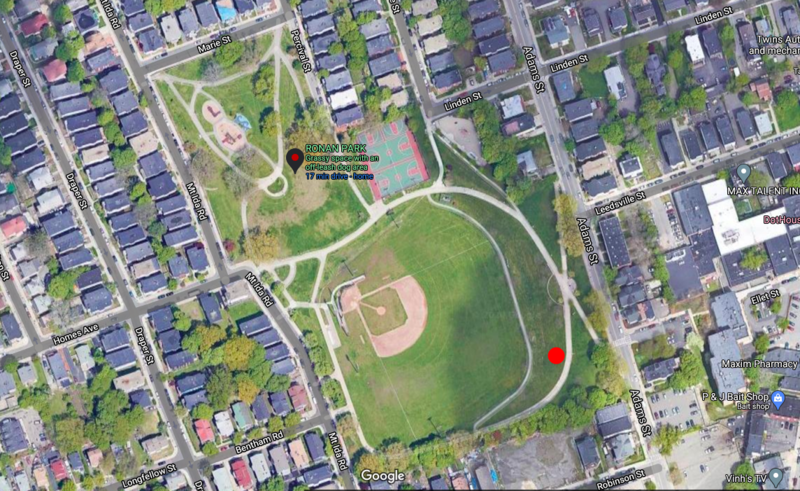City officials provide update on potential sinkhole in Dorchester park
The Ronan Park cavity is a 19th century well, say City Archaeologist and Parks Commissioner.
Boston Parks Commissioner Ryan Woods and City Archaeologist Joe Bagley held a press conference yesterday morning at Ronan Park in Dorchester to announce their findings on the cause of a sinkhole discovered at the site by a park user the previous Sunday. As soon as the hole was reported, the Commissioner was on scene immediately along with Boston Police and Boston Fire to secure the perimeter and ensure that the area was safe for the public.
“After first discovering the hole, our next step was to bring in an outside engineering firm that specializes in this type of work. It never would have occurred to me that it was an archaeological site until word got around to Joe Bagley, who suggested it could be a well. Turns out his hunch was right,” said Commissioner Woods. “Our mission is to maintain clean, safe, and green open spaces for all Bostonians and I am glad that this issue was addressed swiftly to bring the park back online for the community.”
City Archaeologist Bagley did a video inspection of the hole on Tuesday, December 8. According to his preliminary findings the hole was originally a well associated with the house of Mary Pierce that would have been in use until the house received running water in the late 19th century. The house was demolished in 1912 to create the park, after the land was sold to the city. Bagley noted that there were no remains of people or animals visible in the well.
“Boston is an old city, with many mysteries still hiding under its surface,” said City of Boston Archaeologist Joe Bagley. “It's amazing to see this piece of an old Dorchester estate in a park. Open wells are, fortunately, very uncommon.”
The hole measured 16.5 feet deep with the opening at the surface 4 feet wide. There was 10 feet of fill from the 20th century on top of what appeared to be an original yard surface and the “top” of the well. At the time of the inspection the well measured 6.5 feet deep from its top (under 10 feet of fill) to the current bottom. The well is 2.5 feet wide and was once deeper, but it was partially filled by the soils that collapsed into the well after its original cap filled. Bagley estimated that the well was at least double its current depth.
The well was made from unmortared field cobbles with cut granite slabs at its top. This is a similar construction to a 19th century well Bagley’s team documented on Pinckney Street on Beacon Hill. It appears that one or more of the granite slabs at the top, or some other cover that was over the well, failed, and the upper fills sunk into the open well aided by a rainstorm. An iron pipe near the surface of the ground appeared to be intact. There were no other utilities seen in or around the well.
Bagley is taking the data his team collected and will file a final detailed report to determine when Mary Pierce’s house was built to get an approximate date of the well's construction (currently estimated to be mid-19th century), determine exactly where the well is located based on measurements taken at the site and both historic and modern maps and plans, create images from videos for the report, and compare the site to the Pinckney Street well. This is the third well-like hole Bagley has documented since 2016.
The hole will be filled in and re-seeded by the end of December. The site’s archaeological value has been captured in the notes, photos, and videos recorded by the City’s archaeological team, and will add to the existing body of knowledge about how wells were constructed and where they were sited.
Boston’s Archaeology Program is a national leader in public and community-based archaeology. As part of the Landmarks Commissions staff and the City’s Environment Department, Joe and his team serve the public to preserve, protect, and promote the archaeological resources of Boston through digs, exhibits, and educational programs. Efforts are currently underway to process, rehouse, catalog, and photograph more than 200,000 Boston artifacts. By uncovering, sharing and preserving Boston’s rich and diverse history, the Archaeology team gives Boston the opportunity to clarify our past, imagine our future, and grow as a more connected, stronger, and vibrant community. Boston has hundreds of known archaeological sites within its borders. For more information on how the City conducts an archaeology dig, from start to finish, visit Boston.gov/archaeology.





